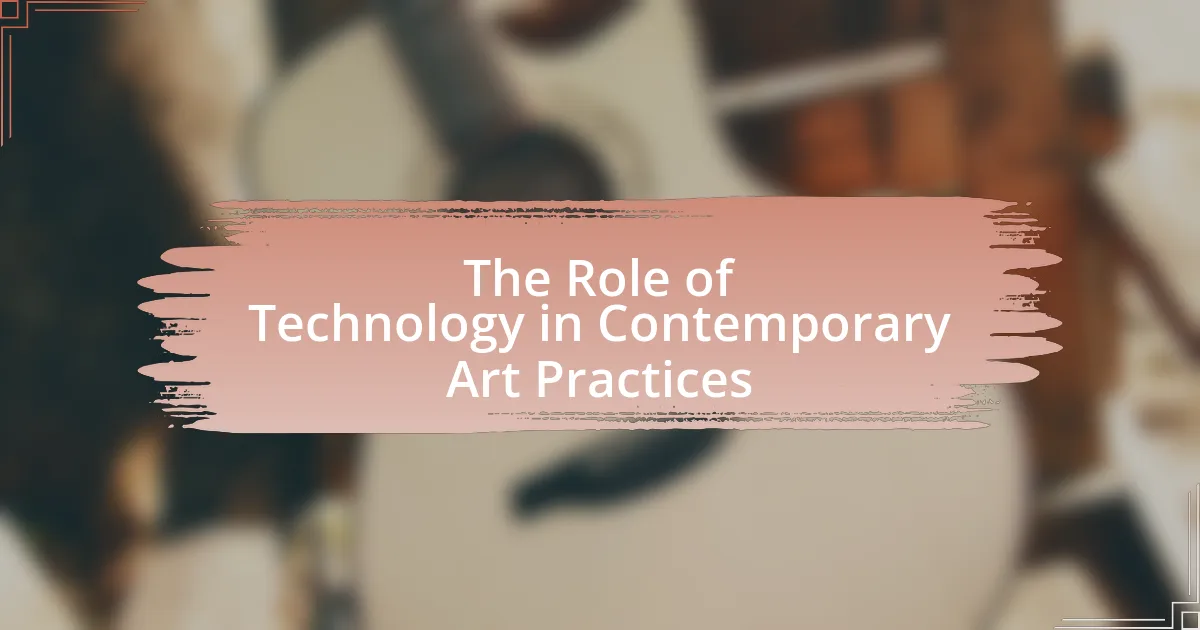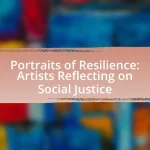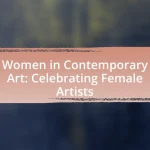The article examines the significant role of technology in contemporary art practices, highlighting how digital tools and platforms have transformed artistic expression and audience engagement. It discusses key technological advancements such as virtual reality, augmented reality, artificial intelligence, and blockchain, which have reshaped the creation, distribution, and consumption of art. The integration of technology not only expands creative possibilities for artists but also raises ethical considerations and challenges traditional art practices. Additionally, the article addresses the skills artists need to thrive in a tech-driven environment and the importance of collaboration with technologists in enhancing artistic outcomes.
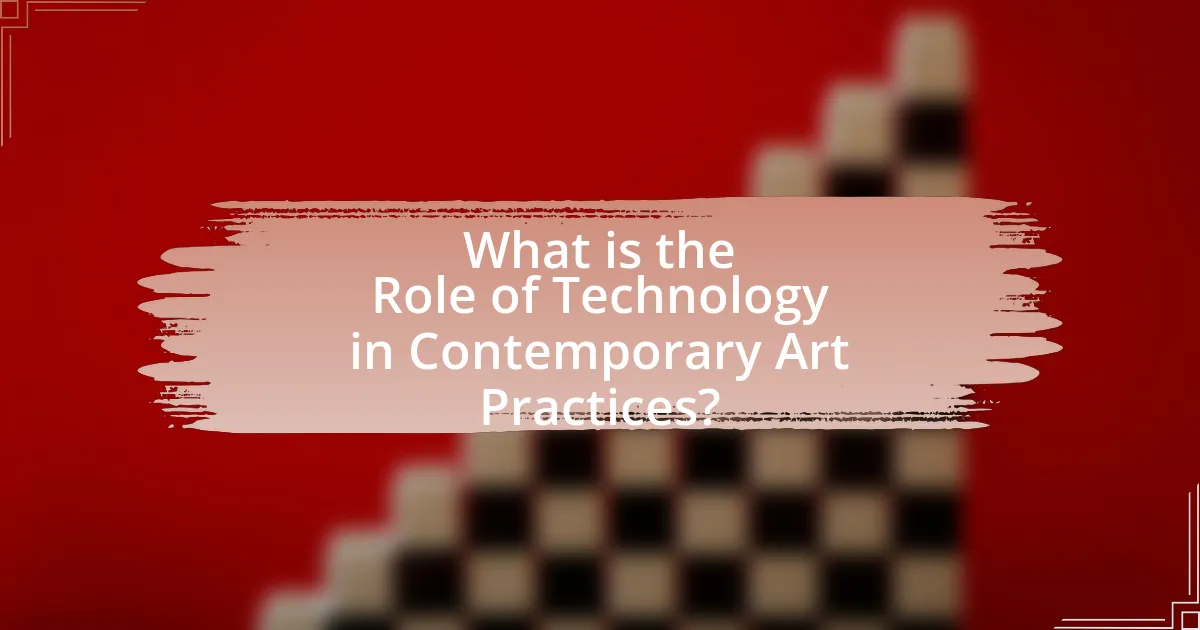
What is the Role of Technology in Contemporary Art Practices?
Technology plays a crucial role in contemporary art practices by enabling new forms of expression and interaction. Artists utilize digital tools, such as software for graphic design, 3D modeling, and virtual reality, to create innovative works that challenge traditional boundaries. For instance, the rise of digital art platforms and social media has transformed how artists share their work and engage with audiences, allowing for broader reach and immediate feedback. Additionally, technologies like augmented reality and artificial intelligence are being integrated into artworks, creating immersive experiences that enhance viewer engagement. This integration of technology not only expands the creative possibilities for artists but also reflects the evolving relationship between art and society in the digital age.
How has technology influenced the evolution of contemporary art?
Technology has significantly influenced the evolution of contemporary art by enabling new forms of expression and expanding the accessibility of art. Digital tools such as graphic design software, 3D printing, and virtual reality have allowed artists to create innovative works that challenge traditional mediums. For instance, the rise of digital art platforms has democratized art creation and distribution, allowing artists to reach global audiences without the constraints of physical galleries. Additionally, the integration of technology in art has led to the emergence of interactive installations and multimedia performances, which engage viewers in novel ways. This shift is evidenced by the increasing prevalence of art created using artificial intelligence, as seen in works by artists like Refik Anadol, who utilizes algorithms to generate immersive experiences. Overall, technology has transformed the landscape of contemporary art, fostering creativity and collaboration across diverse artistic practices.
What are the key technological advancements impacting contemporary art?
Key technological advancements impacting contemporary art include digital media, virtual reality (VR), augmented reality (AR), artificial intelligence (AI), and blockchain technology. Digital media has transformed how artists create and share their work, allowing for new forms of expression and accessibility. Virtual reality and augmented reality enable immersive experiences, engaging audiences in ways traditional art forms cannot. Artificial intelligence is being used to generate art and assist artists in the creative process, pushing the boundaries of creativity. Blockchain technology offers new methods for provenance and ownership, enhancing the art market’s transparency and security. These advancements collectively reshape the landscape of contemporary art, influencing both creation and consumption.
How do artists integrate technology into their creative processes?
Artists integrate technology into their creative processes by utilizing digital tools, software, and platforms to enhance their artistic expression and production. For instance, many artists employ graphic design software like Adobe Photoshop or 3D modeling programs to create intricate visual works that would be difficult to achieve by traditional means. Additionally, artists use digital media such as video, animation, and interactive installations to engage audiences in innovative ways. The incorporation of technology also includes the use of social media for sharing their work and connecting with a global audience, thus expanding their reach and influence. According to a study published in the journal “Leonardo,” artists who embrace technology often report increased creativity and new avenues for collaboration, demonstrating the significant impact of technological integration on contemporary art practices.
Why is technology essential for modern artists?
Technology is essential for modern artists because it expands their creative possibilities and enhances their ability to reach audiences. Digital tools and software allow artists to experiment with new mediums, such as digital painting, 3D modeling, and interactive installations, which were not possible with traditional methods. For instance, the rise of social media platforms enables artists to showcase their work globally, facilitating direct engagement with a wider audience and potential buyers. According to a 2021 survey by the National Endowment for the Arts, 53% of artists reported using digital platforms to promote their work, highlighting the integral role of technology in contemporary art practices.
What advantages does technology provide in artistic expression?
Technology enhances artistic expression by providing tools that expand creativity, accessibility, and collaboration. Digital platforms enable artists to create and share their work globally, reaching wider audiences than traditional methods allow. For instance, software like Adobe Creative Suite offers advanced capabilities for graphic design, while social media platforms facilitate instant feedback and community engagement. Additionally, technologies such as virtual reality and 3D printing allow for innovative forms of art that were previously unimaginable, enabling artists to explore new dimensions and experiences. These advancements demonstrate how technology not only enriches the artistic process but also democratizes art, making it more inclusive and diverse.
How does technology enhance audience engagement with art?
Technology enhances audience engagement with art by providing interactive experiences that allow viewers to connect with artworks on a deeper level. For instance, augmented reality (AR) applications enable users to visualize additional layers of information or artistic elements that are not physically present, thus enriching their understanding and appreciation of the art. A study by the Pew Research Center found that 72% of art institutions reported increased visitor engagement through digital tools, demonstrating the effectiveness of technology in fostering a more immersive experience. Additionally, social media platforms facilitate real-time interaction between artists and audiences, allowing for immediate feedback and community building around art, which further enhances engagement.
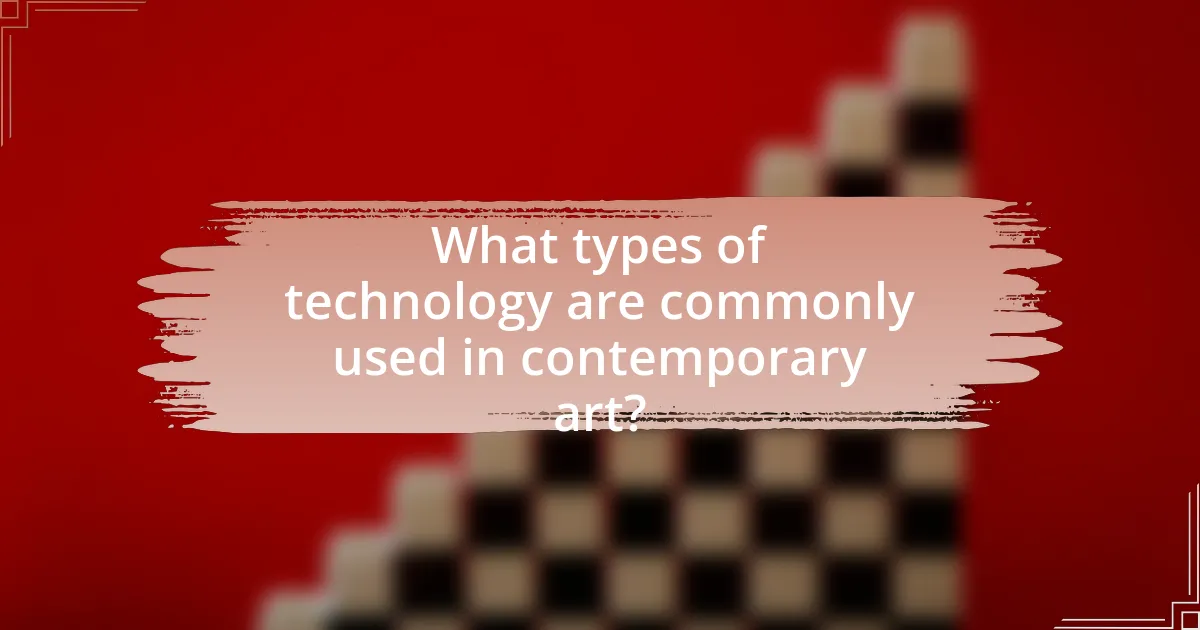
What types of technology are commonly used in contemporary art?
Contemporary art commonly utilizes digital technology, including software for graphic design, 3D modeling, and video editing. Artists frequently employ tools such as virtual reality (VR) and augmented reality (AR) to create immersive experiences. Additionally, interactive installations often incorporate sensors and microcontrollers, enabling audience engagement. The use of artificial intelligence (AI) in generating artwork has also gained traction, with algorithms producing unique pieces. These technologies reflect the evolving landscape of artistic expression, as evidenced by exhibitions showcasing digital art and interactive media, highlighting their significance in contemporary practices.
How do digital tools shape the creation of contemporary artworks?
Digital tools significantly shape the creation of contemporary artworks by enabling artists to explore new mediums, techniques, and collaborative processes. These tools, such as graphic design software, 3D modeling programs, and digital painting applications, allow for greater experimentation and innovation in artistic expression. For instance, the use of software like Adobe Photoshop and Blender facilitates the manipulation of images and the creation of complex visual compositions that would be difficult to achieve through traditional methods. Additionally, digital platforms enable artists to collaborate across geographical boundaries, as seen in projects like the “Global Art Project,” which connects artists worldwide through digital means. This integration of technology not only expands the possibilities for artistic creation but also influences the way audiences engage with and experience art in the contemporary landscape.
What role do software and applications play in art production?
Software and applications are integral to art production, enabling artists to create, manipulate, and distribute their work efficiently. These digital tools facilitate various artistic processes, from graphic design and digital painting to 3D modeling and animation. For instance, programs like Adobe Photoshop and Illustrator allow for intricate image editing and vector graphics creation, while software such as Blender and Maya support 3D art and animation. The use of these applications has transformed traditional art forms, allowing for innovative techniques and new mediums, such as digital installations and interactive art. Furthermore, the accessibility of software has democratized art production, enabling a broader range of individuals to engage in creative practices, thus expanding the art community.
How do digital platforms influence art distribution and accessibility?
Digital platforms significantly enhance art distribution and accessibility by allowing artists to reach global audiences without traditional barriers. These platforms, such as social media, online galleries, and streaming services, enable artists to showcase their work to millions, bypassing the limitations of physical galleries and exhibitions. For instance, a study by the National Endowment for the Arts in 2020 indicated that 53% of U.S. adults engaged with art online, demonstrating the widespread reach and impact of digital mediums. Additionally, platforms like Instagram and Etsy provide tools for artists to sell their work directly to consumers, fostering a more inclusive art market. This shift not only democratizes access to art but also empowers artists by giving them control over their distribution channels.
What impact does virtual and augmented reality have on art experiences?
Virtual and augmented reality significantly enhances art experiences by providing immersive environments that engage viewers in novel ways. These technologies allow artists to create interactive installations that can transform traditional art forms, enabling audiences to experience art beyond visual observation. For instance, virtual reality can transport users into a 3D space where they can interact with digital sculptures or paintings, while augmented reality can overlay digital elements onto physical artworks, enriching the viewer’s understanding and appreciation. Research by the University of Southern California found that immersive experiences can increase emotional engagement and retention of information about the artwork, demonstrating that these technologies not only alter how art is consumed but also deepen the connection between the viewer and the art itself.
How do VR and AR technologies transform viewer interactions with art?
VR and AR technologies transform viewer interactions with art by creating immersive experiences that engage audiences in novel ways. These technologies allow viewers to step inside artworks or interact with them in real-time, enhancing emotional and cognitive engagement. For instance, VR can transport users to a virtual gallery where they can explore 3D representations of art pieces, while AR can overlay digital information or animations onto physical artworks, providing deeper context and interactivity. Research by the University of Southern California highlights that such immersive experiences can increase viewer retention and understanding of art, demonstrating that technology significantly alters traditional viewing paradigms.
What are some notable examples of VR and AR in contemporary art?
Notable examples of VR and AR in contemporary art include “The Night Cafe” by Vincent Morisset, which immerses viewers in a virtual recreation of Vincent van Gogh’s painting, and “Augmented Reality Art” by artists like KAWS, who use AR to enhance physical artworks with digital layers. Additionally, “Tree of Life” by artist and researcher Kira O’Reilly employs AR to explore themes of nature and technology, allowing viewers to interact with the artwork through their devices. These examples demonstrate how contemporary artists leverage VR and AR to create immersive experiences that challenge traditional art forms and engage audiences in innovative ways.
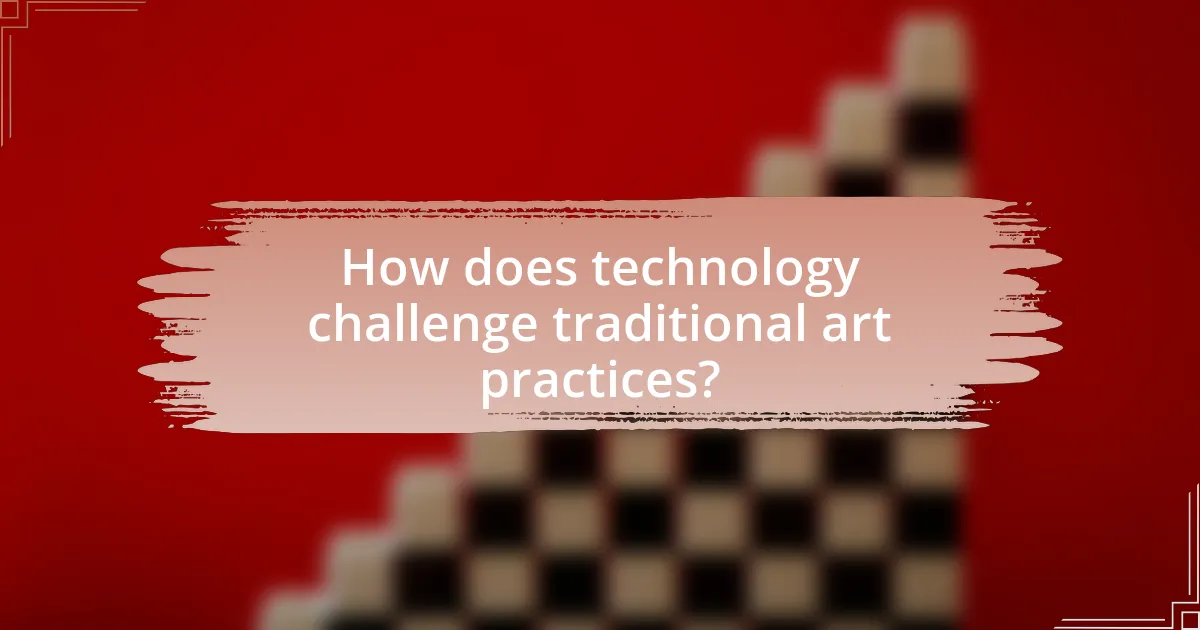
How does technology challenge traditional art practices?
Technology challenges traditional art practices by introducing new mediums and methods that alter the creation, distribution, and consumption of art. Digital tools, such as graphic design software and 3D printing, enable artists to explore innovative forms that were previously unattainable, thereby expanding the definition of what constitutes art. For instance, the rise of digital art platforms has democratized access to art creation and appreciation, allowing a broader audience to engage with art outside conventional galleries. Additionally, technology facilitates interactive and immersive experiences, such as virtual reality installations, which transform the viewer’s role from passive observer to active participant. This shift not only redefines artistic expression but also raises questions about authenticity and the value of traditional techniques, as evidenced by the increasing prevalence of AI-generated artworks in exhibitions.
What are the criticisms of technology in contemporary art?
Criticisms of technology in contemporary art include concerns about authenticity, accessibility, and the potential for alienation. Critics argue that technology can undermine the traditional artistic process, leading to a perception that art is less genuine or meaningful when created through digital means. Additionally, the reliance on technology can create barriers for audiences who may lack access to the necessary tools or skills to engage with digital art forms. Furthermore, some believe that technology can foster a sense of detachment, as the immersive experiences often associated with digital art may not resonate on an emotional level as traditional art forms do. These criticisms highlight the ongoing debate about the value and impact of technology in the evolving landscape of contemporary art.
How do some artists resist technological integration in their work?
Some artists resist technological integration in their work by prioritizing traditional techniques and materials over digital tools. This resistance often manifests in the use of handcrafted methods, such as painting, sculpture, or printmaking, which emphasize tactile engagement and personal expression. For instance, artists like Agnes Martin and Donald Judd have focused on minimalist aesthetics that rely on physical materials rather than digital manipulation, highlighting the value of human touch and the imperfections inherent in manual processes. This approach not only critiques the pervasive influence of technology in art but also reaffirms the significance of the artist’s hand in creating meaning and emotional resonance.
What ethical considerations arise from the use of technology in art?
The ethical considerations arising from the use of technology in art include issues of authorship, authenticity, and accessibility. The integration of technology can blur the lines of authorship, as collaborative tools and AI-generated works challenge traditional notions of who is the creator. For instance, when an artist uses AI to generate artwork, questions arise about the originality and ownership of the final piece. Additionally, the authenticity of digital art can be questioned, especially with the rise of deepfakes and digital reproductions that can mislead viewers. Furthermore, accessibility becomes a concern, as not all artists have equal access to advanced technologies, potentially widening the gap between those who can afford such tools and those who cannot. These considerations highlight the need for ongoing dialogue about the implications of technology in the art world.
How does technology redefine the role of the artist?
Technology redefines the role of the artist by transforming their creative processes, expanding their tools, and altering their relationship with audiences. Artists now utilize digital platforms, software, and hardware to create and distribute their work, enabling new forms of expression such as digital art, virtual reality, and interactive installations. For instance, the rise of social media allows artists to reach global audiences instantly, fostering direct engagement and feedback, which was not possible in traditional art forms. Additionally, technology facilitates collaboration across disciplines, as seen in projects that combine art with science and technology, exemplified by initiatives like the MIT Media Lab’s Art and Science collaborations. This evolution illustrates how technology not only enhances artistic capabilities but also reshapes the cultural landscape in which artists operate.
What new skills do contemporary artists need to thrive in a tech-driven environment?
Contemporary artists need to acquire digital literacy, data visualization, and coding skills to thrive in a tech-driven environment. Digital literacy enables artists to effectively use software tools for creating and editing art, while data visualization skills allow them to interpret and present complex information visually, enhancing their storytelling capabilities. Coding skills are increasingly important as artists engage with interactive installations and digital platforms, allowing them to create immersive experiences. According to a report by the National Endowment for the Arts, artists who integrate technology into their practice can reach wider audiences and innovate their art forms, demonstrating the necessity of these skills in the modern art landscape.
How does collaboration with technologists influence artistic outcomes?
Collaboration with technologists significantly enhances artistic outcomes by integrating advanced tools and methodologies into the creative process. This partnership allows artists to explore new mediums, such as digital art, interactive installations, and augmented reality, which can lead to innovative expressions and experiences. For instance, the collaboration between artist Rafael Lozano-Hemmer and technologists has resulted in interactive artworks that engage audiences in real-time, demonstrating how technology can transform traditional art forms. Such collaborations not only expand the artist’s toolkit but also foster interdisciplinary dialogue, ultimately enriching the artistic landscape.
What are best practices for integrating technology into art practices?
Best practices for integrating technology into art practices include embracing interdisciplinary collaboration, utilizing digital tools for creation and distribution, and engaging with audiences through interactive experiences. Interdisciplinary collaboration fosters innovation by combining artistic vision with technological expertise, as seen in projects like the collaboration between artists and software developers in creating immersive installations. Utilizing digital tools, such as graphic design software and 3D printing, enhances the creative process and expands the possibilities of artistic expression, evidenced by the rise of digital art forms. Engaging audiences through interactive experiences, such as augmented reality and virtual reality installations, creates a participatory environment that enhances viewer engagement, as demonstrated by exhibitions that allow visitors to interact with the artwork. These practices not only enhance the artistic process but also broaden the reach and impact of art in contemporary society.
How can artists effectively choose the right technology for their work?
Artists can effectively choose the right technology for their work by assessing their specific artistic needs and the capabilities of available tools. This involves identifying the desired outcomes of their projects, such as the medium, style, and audience engagement, and then researching technologies that align with these goals. For instance, artists interested in digital painting may explore software like Adobe Photoshop or Procreate, while those focused on interactive installations might consider tools like Arduino or Unity.
Additionally, artists should evaluate the learning curve associated with each technology, as well as the community support and resources available for troubleshooting and skill development. According to a study published in the Journal of Visual Arts Practice, artists who engage with technology through workshops and peer collaboration report higher satisfaction and effectiveness in their creative processes. This evidence underscores the importance of not only selecting the right tools but also integrating them into a supportive learning environment.
What resources are available for artists looking to explore technology in their practice?
Artists looking to explore technology in their practice can access a variety of resources, including online platforms, workshops, and funding opportunities. Online platforms such as Creative Coding and Processing provide tools and tutorials for digital art creation. Workshops offered by institutions like the School of Visual Arts and local art centers often focus on integrating technology into artistic practices. Additionally, funding opportunities from organizations like the National Endowment for the Arts support projects that incorporate technology. These resources collectively enable artists to enhance their work through technological innovation.
